Analysis of WA Schools PPP Project Procurement Report
VerifiedAdded on 2022/11/28
|9
|1908
|64
Report
AI Summary
This report analyzes the WA Schools Public Private Partnership (PPP) project procurement, focusing on the audit conducted to assess the project's progress and adherence to the contract. The project, a $631 million deal between EduWest and the WA government, aimed to construct and maintain eight schools. The audit, led by the Office of the Auditor General, revealed a robust pre-contract procurement process, with transparent tendering and a merit-based selection of EduWest. The project was found to be on track, with a sound governance structure. However, the Department of Education (DoE) lacked preparedness, particularly in contract management and audit plans. The report offers recommendations for both pre- and post-contract activities, including improving the DoE's management processes and developing monitoring programs for EduWest. The recommendations aim to enhance the efficiency and success of the project's implementation, ensuring high-quality educational facilities.
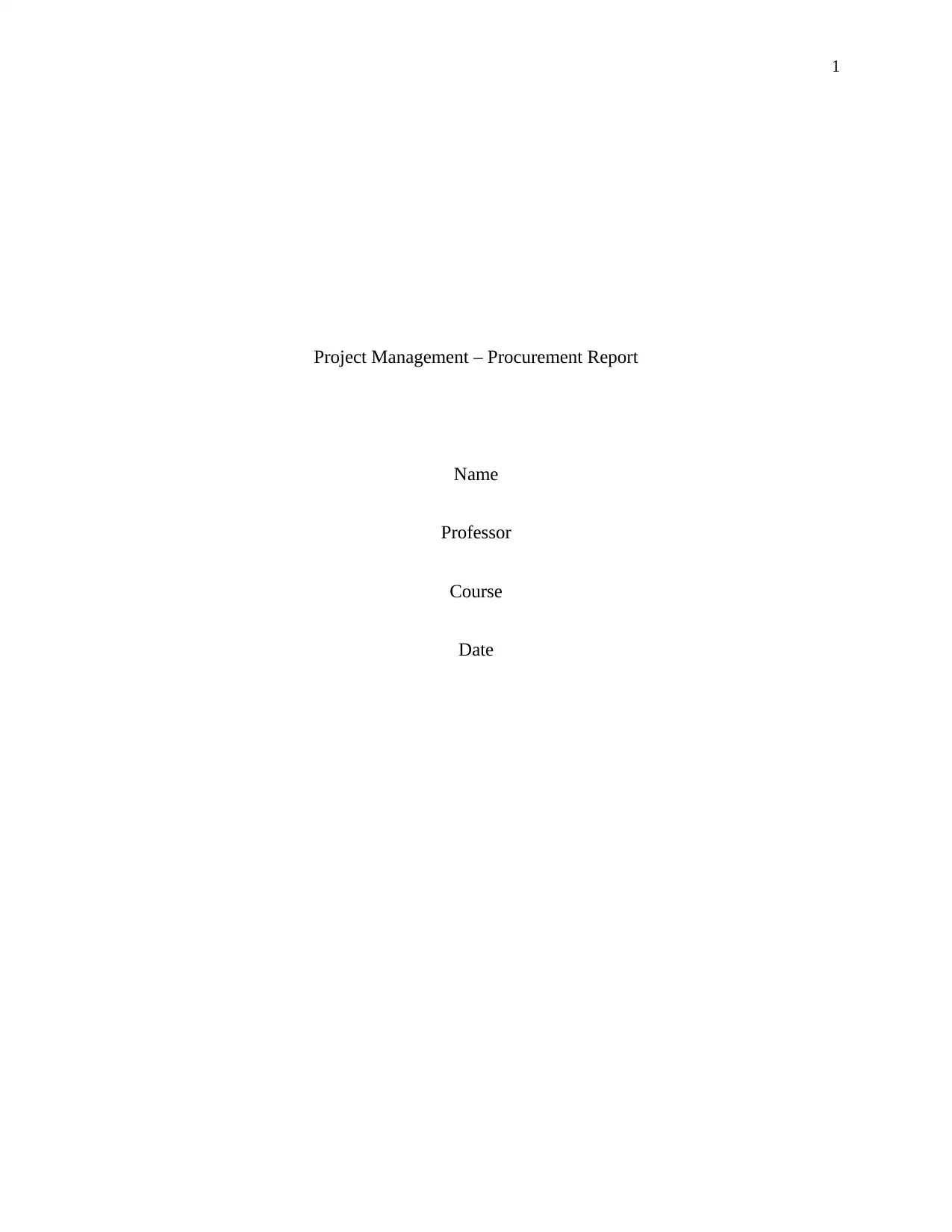
1
Project Management – Procurement Report
Name
Professor
Course
Date
Project Management – Procurement Report
Name
Professor
Course
Date
Paraphrase This Document
Need a fresh take? Get an instant paraphrase of this document with our AI Paraphraser
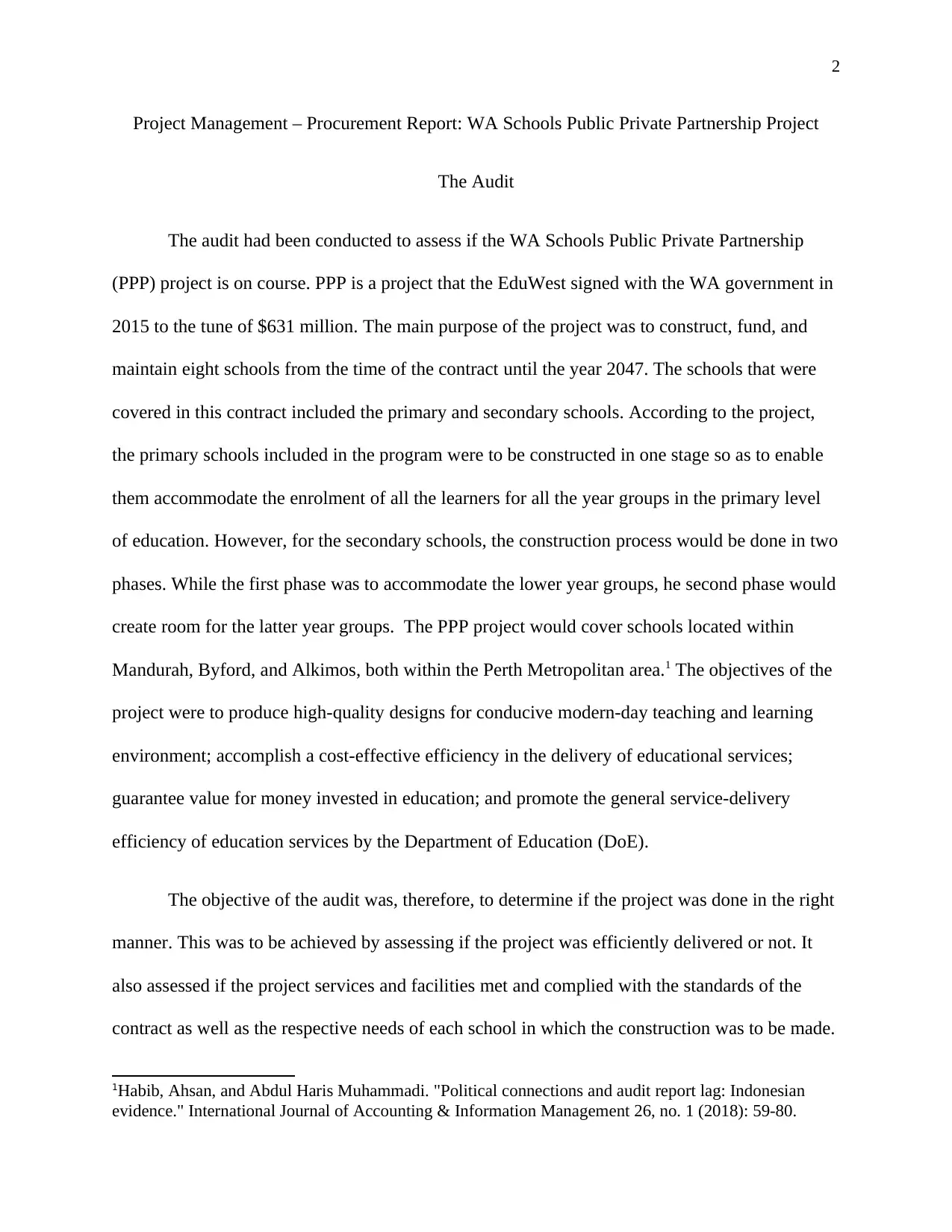
2
Project Management – Procurement Report: WA Schools Public Private Partnership Project
The Audit
The audit had been conducted to assess if the WA Schools Public Private Partnership
(PPP) project is on course. PPP is a project that the EduWest signed with the WA government in
2015 to the tune of $631 million. The main purpose of the project was to construct, fund, and
maintain eight schools from the time of the contract until the year 2047. The schools that were
covered in this contract included the primary and secondary schools. According to the project,
the primary schools included in the program were to be constructed in one stage so as to enable
them accommodate the enrolment of all the learners for all the year groups in the primary level
of education. However, for the secondary schools, the construction process would be done in two
phases. While the first phase was to accommodate the lower year groups, he second phase would
create room for the latter year groups. The PPP project would cover schools located within
Mandurah, Byford, and Alkimos, both within the Perth Metropolitan area.1 The objectives of the
project were to produce high-quality designs for conducive modern-day teaching and learning
environment; accomplish a cost-effective efficiency in the delivery of educational services;
guarantee value for money invested in education; and promote the general service-delivery
efficiency of education services by the Department of Education (DoE).
The objective of the audit was, therefore, to determine if the project was done in the right
manner. This was to be achieved by assessing if the project was efficiently delivered or not. It
also assessed if the project services and facilities met and complied with the standards of the
contract as well as the respective needs of each school in which the construction was to be made.
1Habib, Ahsan, and Abdul Haris Muhammadi. "Political connections and audit report lag: Indonesian
evidence." International Journal of Accounting & Information Management 26, no. 1 (2018): 59-80.
Project Management – Procurement Report: WA Schools Public Private Partnership Project
The Audit
The audit had been conducted to assess if the WA Schools Public Private Partnership
(PPP) project is on course. PPP is a project that the EduWest signed with the WA government in
2015 to the tune of $631 million. The main purpose of the project was to construct, fund, and
maintain eight schools from the time of the contract until the year 2047. The schools that were
covered in this contract included the primary and secondary schools. According to the project,
the primary schools included in the program were to be constructed in one stage so as to enable
them accommodate the enrolment of all the learners for all the year groups in the primary level
of education. However, for the secondary schools, the construction process would be done in two
phases. While the first phase was to accommodate the lower year groups, he second phase would
create room for the latter year groups. The PPP project would cover schools located within
Mandurah, Byford, and Alkimos, both within the Perth Metropolitan area.1 The objectives of the
project were to produce high-quality designs for conducive modern-day teaching and learning
environment; accomplish a cost-effective efficiency in the delivery of educational services;
guarantee value for money invested in education; and promote the general service-delivery
efficiency of education services by the Department of Education (DoE).
The objective of the audit was, therefore, to determine if the project was done in the right
manner. This was to be achieved by assessing if the project was efficiently delivered or not. It
also assessed if the project services and facilities met and complied with the standards of the
contract as well as the respective needs of each school in which the construction was to be made.
1Habib, Ahsan, and Abdul Haris Muhammadi. "Political connections and audit report lag: Indonesian
evidence." International Journal of Accounting & Information Management 26, no. 1 (2018): 59-80.
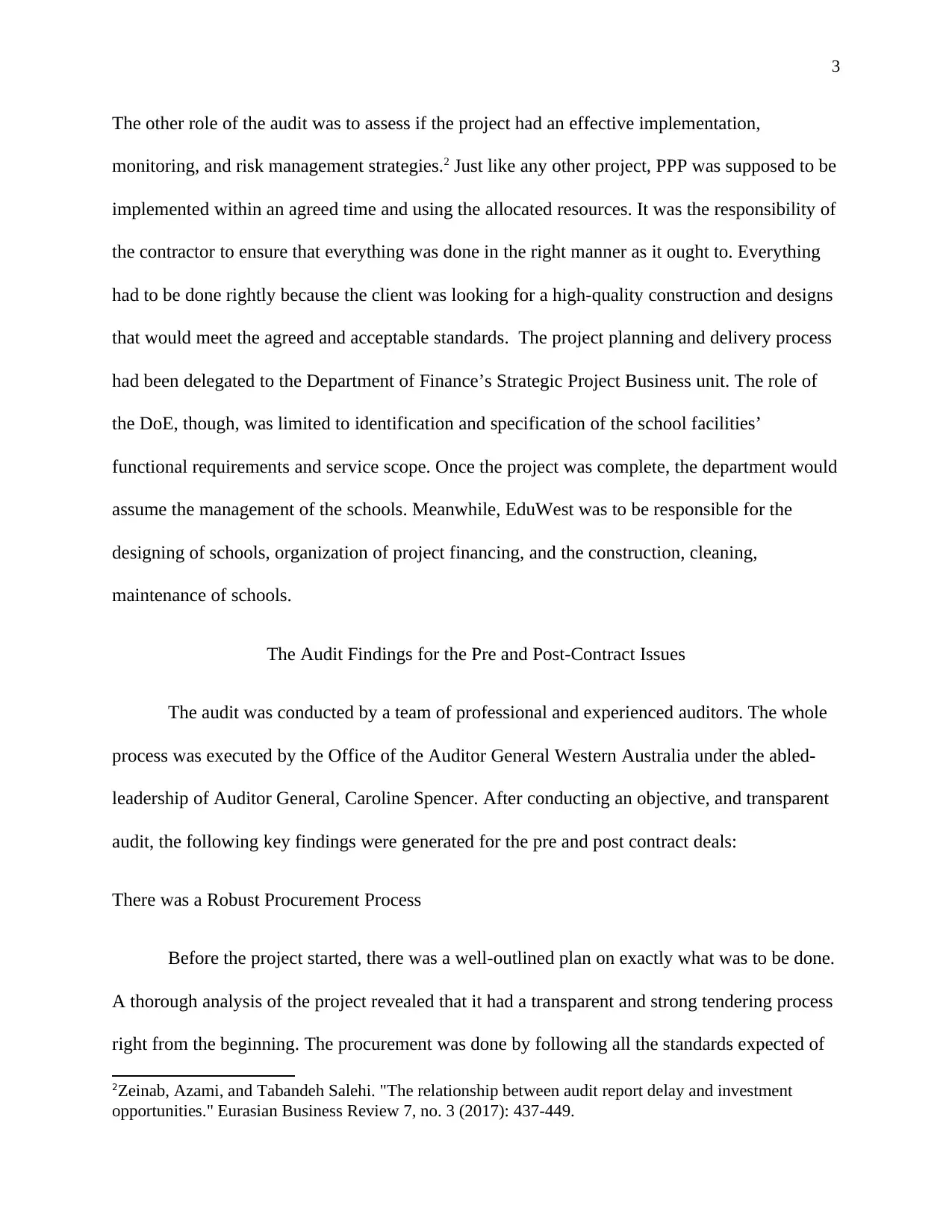
3
The other role of the audit was to assess if the project had an effective implementation,
monitoring, and risk management strategies.2 Just like any other project, PPP was supposed to be
implemented within an agreed time and using the allocated resources. It was the responsibility of
the contractor to ensure that everything was done in the right manner as it ought to. Everything
had to be done rightly because the client was looking for a high-quality construction and designs
that would meet the agreed and acceptable standards. The project planning and delivery process
had been delegated to the Department of Finance’s Strategic Project Business unit. The role of
the DoE, though, was limited to identification and specification of the school facilities’
functional requirements and service scope. Once the project was complete, the department would
assume the management of the schools. Meanwhile, EduWest was to be responsible for the
designing of schools, organization of project financing, and the construction, cleaning,
maintenance of schools.
The Audit Findings for the Pre and Post-Contract Issues
The audit was conducted by a team of professional and experienced auditors. The whole
process was executed by the Office of the Auditor General Western Australia under the abled-
leadership of Auditor General, Caroline Spencer. After conducting an objective, and transparent
audit, the following key findings were generated for the pre and post contract deals:
There was a Robust Procurement Process
Before the project started, there was a well-outlined plan on exactly what was to be done.
A thorough analysis of the project revealed that it had a transparent and strong tendering process
right from the beginning. The procurement was done by following all the standards expected of
2Zeinab, Azami, and Tabandeh Salehi. "The relationship between audit report delay and investment
opportunities." Eurasian Business Review 7, no. 3 (2017): 437-449.
The other role of the audit was to assess if the project had an effective implementation,
monitoring, and risk management strategies.2 Just like any other project, PPP was supposed to be
implemented within an agreed time and using the allocated resources. It was the responsibility of
the contractor to ensure that everything was done in the right manner as it ought to. Everything
had to be done rightly because the client was looking for a high-quality construction and designs
that would meet the agreed and acceptable standards. The project planning and delivery process
had been delegated to the Department of Finance’s Strategic Project Business unit. The role of
the DoE, though, was limited to identification and specification of the school facilities’
functional requirements and service scope. Once the project was complete, the department would
assume the management of the schools. Meanwhile, EduWest was to be responsible for the
designing of schools, organization of project financing, and the construction, cleaning,
maintenance of schools.
The Audit Findings for the Pre and Post-Contract Issues
The audit was conducted by a team of professional and experienced auditors. The whole
process was executed by the Office of the Auditor General Western Australia under the abled-
leadership of Auditor General, Caroline Spencer. After conducting an objective, and transparent
audit, the following key findings were generated for the pre and post contract deals:
There was a Robust Procurement Process
Before the project started, there was a well-outlined plan on exactly what was to be done.
A thorough analysis of the project revealed that it had a transparent and strong tendering process
right from the beginning. The procurement was done by following all the standards expected of
2Zeinab, Azami, and Tabandeh Salehi. "The relationship between audit report delay and investment
opportunities." Eurasian Business Review 7, no. 3 (2017): 437-449.
⊘ This is a preview!⊘
Do you want full access?
Subscribe today to unlock all pages.

Trusted by 1+ million students worldwide
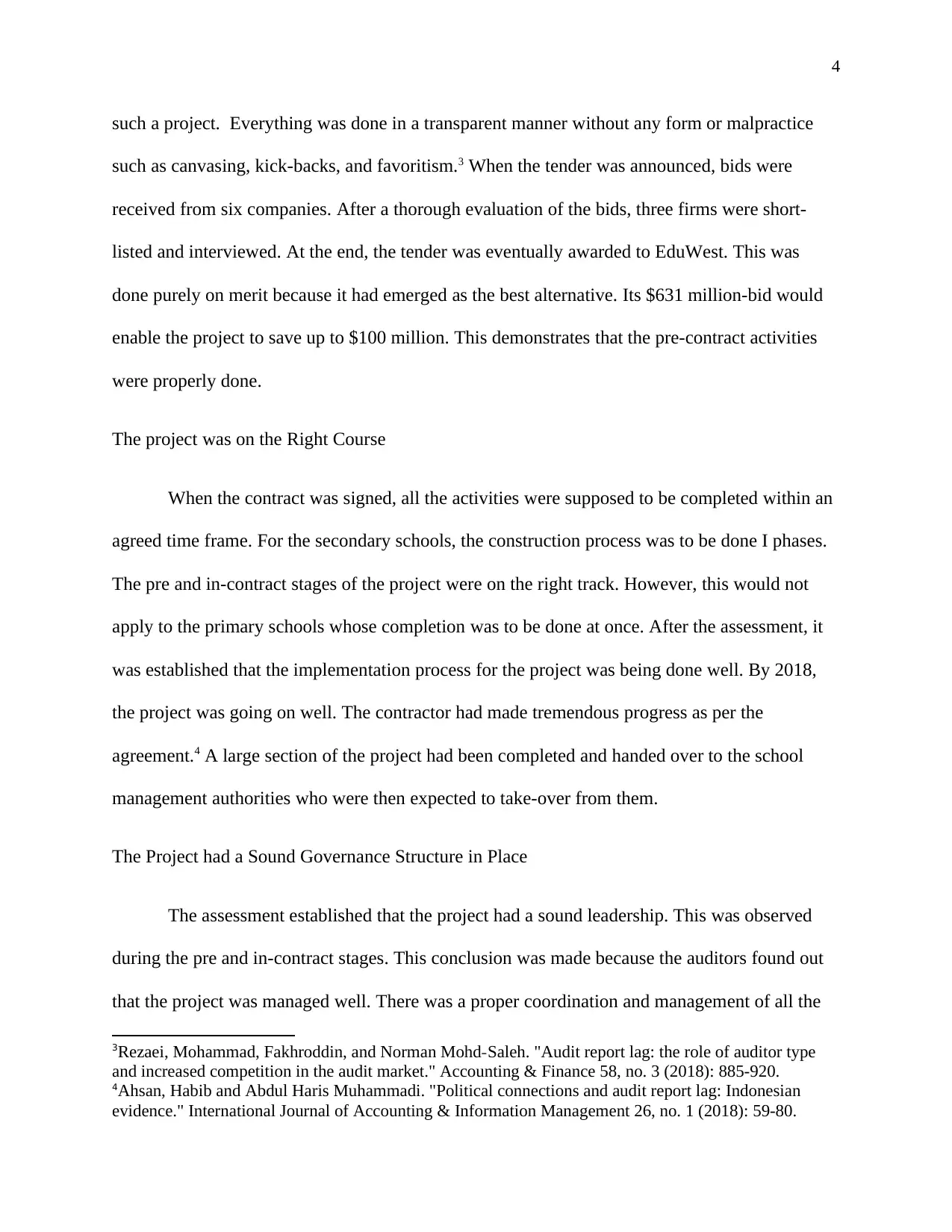
4
such a project. Everything was done in a transparent manner without any form or malpractice
such as canvasing, kick-backs, and favoritism.3 When the tender was announced, bids were
received from six companies. After a thorough evaluation of the bids, three firms were short-
listed and interviewed. At the end, the tender was eventually awarded to EduWest. This was
done purely on merit because it had emerged as the best alternative. Its $631 million-bid would
enable the project to save up to $100 million. This demonstrates that the pre-contract activities
were properly done.
The project was on the Right Course
When the contract was signed, all the activities were supposed to be completed within an
agreed time frame. For the secondary schools, the construction process was to be done I phases.
The pre and in-contract stages of the project were on the right track. However, this would not
apply to the primary schools whose completion was to be done at once. After the assessment, it
was established that the implementation process for the project was being done well. By 2018,
the project was going on well. The contractor had made tremendous progress as per the
agreement.4 A large section of the project had been completed and handed over to the school
management authorities who were then expected to take-over from them.
The Project had a Sound Governance Structure in Place
The assessment established that the project had a sound leadership. This was observed
during the pre and in-contract stages. This conclusion was made because the auditors found out
that the project was managed well. There was a proper coordination and management of all the
3Rezaei, Mohammad, Fakhroddin, and Norman Mohd‐Saleh. "Audit report lag: the role of auditor type
and increased competition in the audit market." Accounting & Finance 58, no. 3 (2018): 885-920.
4Ahsan, Habib and Abdul Haris Muhammadi. "Political connections and audit report lag: Indonesian
evidence." International Journal of Accounting & Information Management 26, no. 1 (2018): 59-80.
such a project. Everything was done in a transparent manner without any form or malpractice
such as canvasing, kick-backs, and favoritism.3 When the tender was announced, bids were
received from six companies. After a thorough evaluation of the bids, three firms were short-
listed and interviewed. At the end, the tender was eventually awarded to EduWest. This was
done purely on merit because it had emerged as the best alternative. Its $631 million-bid would
enable the project to save up to $100 million. This demonstrates that the pre-contract activities
were properly done.
The project was on the Right Course
When the contract was signed, all the activities were supposed to be completed within an
agreed time frame. For the secondary schools, the construction process was to be done I phases.
The pre and in-contract stages of the project were on the right track. However, this would not
apply to the primary schools whose completion was to be done at once. After the assessment, it
was established that the implementation process for the project was being done well. By 2018,
the project was going on well. The contractor had made tremendous progress as per the
agreement.4 A large section of the project had been completed and handed over to the school
management authorities who were then expected to take-over from them.
The Project had a Sound Governance Structure in Place
The assessment established that the project had a sound leadership. This was observed
during the pre and in-contract stages. This conclusion was made because the auditors found out
that the project was managed well. There was a proper coordination and management of all the
3Rezaei, Mohammad, Fakhroddin, and Norman Mohd‐Saleh. "Audit report lag: the role of auditor type
and increased competition in the audit market." Accounting & Finance 58, no. 3 (2018): 885-920.
4Ahsan, Habib and Abdul Haris Muhammadi. "Political connections and audit report lag: Indonesian
evidence." International Journal of Accounting & Information Management 26, no. 1 (2018): 59-80.
Paraphrase This Document
Need a fresh take? Get an instant paraphrase of this document with our AI Paraphraser
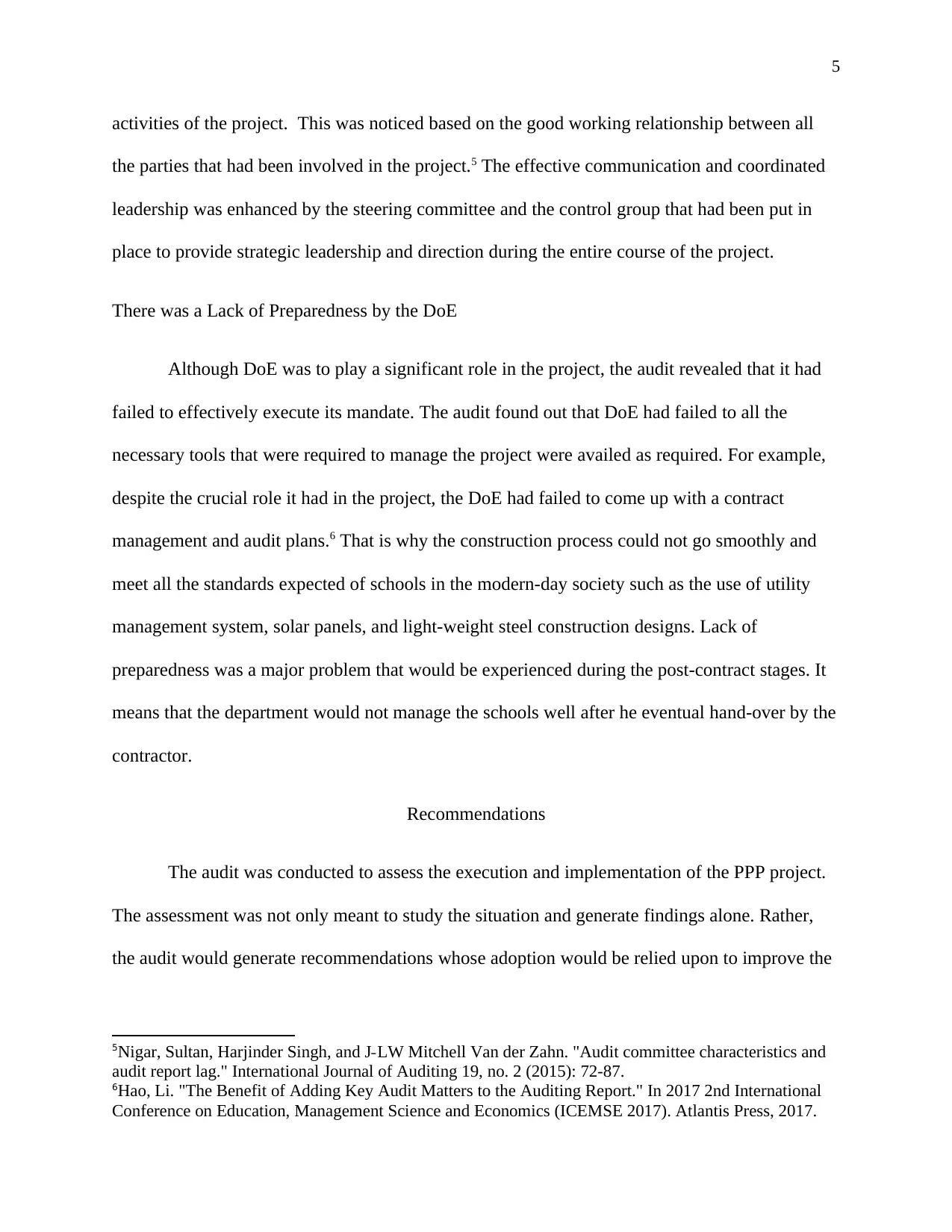
5
activities of the project. This was noticed based on the good working relationship between all
the parties that had been involved in the project.5 The effective communication and coordinated
leadership was enhanced by the steering committee and the control group that had been put in
place to provide strategic leadership and direction during the entire course of the project.
There was a Lack of Preparedness by the DoE
Although DoE was to play a significant role in the project, the audit revealed that it had
failed to effectively execute its mandate. The audit found out that DoE had failed to all the
necessary tools that were required to manage the project were availed as required. For example,
despite the crucial role it had in the project, the DoE had failed to come up with a contract
management and audit plans.6 That is why the construction process could not go smoothly and
meet all the standards expected of schools in the modern-day society such as the use of utility
management system, solar panels, and light-weight steel construction designs. Lack of
preparedness was a major problem that would be experienced during the post-contract stages. It
means that the department would not manage the schools well after he eventual hand-over by the
contractor.
Recommendations
The audit was conducted to assess the execution and implementation of the PPP project.
The assessment was not only meant to study the situation and generate findings alone. Rather,
the audit would generate recommendations whose adoption would be relied upon to improve the
5Nigar, Sultan, Harjinder Singh, and J‐LW Mitchell Van der Zahn. "Audit committee characteristics and
audit report lag." International Journal of Auditing 19, no. 2 (2015): 72-87.
6Hao, Li. "The Benefit of Adding Key Audit Matters to the Auditing Report." In 2017 2nd International
Conference on Education, Management Science and Economics (ICEMSE 2017). Atlantis Press, 2017.
activities of the project. This was noticed based on the good working relationship between all
the parties that had been involved in the project.5 The effective communication and coordinated
leadership was enhanced by the steering committee and the control group that had been put in
place to provide strategic leadership and direction during the entire course of the project.
There was a Lack of Preparedness by the DoE
Although DoE was to play a significant role in the project, the audit revealed that it had
failed to effectively execute its mandate. The audit found out that DoE had failed to all the
necessary tools that were required to manage the project were availed as required. For example,
despite the crucial role it had in the project, the DoE had failed to come up with a contract
management and audit plans.6 That is why the construction process could not go smoothly and
meet all the standards expected of schools in the modern-day society such as the use of utility
management system, solar panels, and light-weight steel construction designs. Lack of
preparedness was a major problem that would be experienced during the post-contract stages. It
means that the department would not manage the schools well after he eventual hand-over by the
contractor.
Recommendations
The audit was conducted to assess the execution and implementation of the PPP project.
The assessment was not only meant to study the situation and generate findings alone. Rather,
the audit would generate recommendations whose adoption would be relied upon to improve the
5Nigar, Sultan, Harjinder Singh, and J‐LW Mitchell Van der Zahn. "Audit committee characteristics and
audit report lag." International Journal of Auditing 19, no. 2 (2015): 72-87.
6Hao, Li. "The Benefit of Adding Key Audit Matters to the Auditing Report." In 2017 2nd International
Conference on Education, Management Science and Economics (ICEMSE 2017). Atlantis Press, 2017.
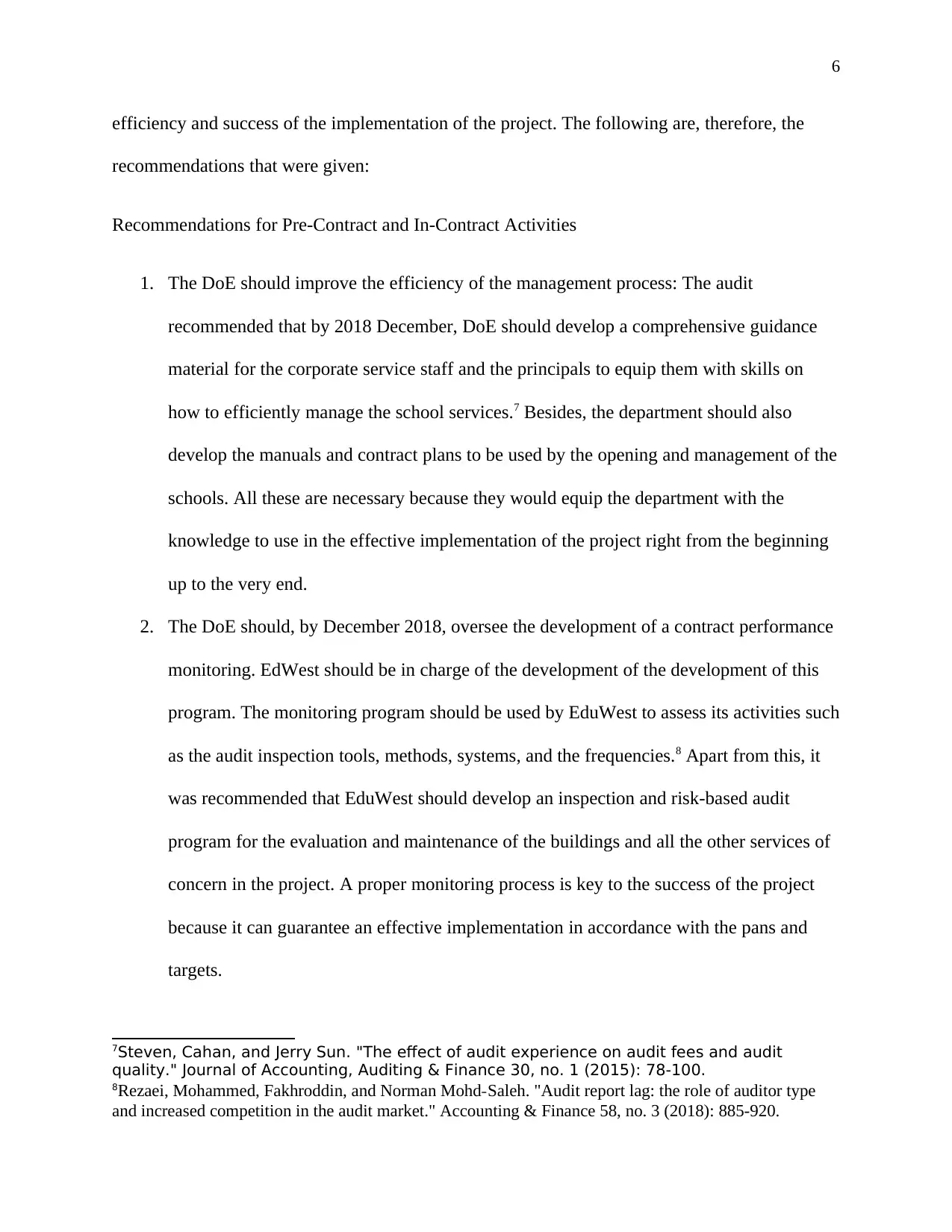
6
efficiency and success of the implementation of the project. The following are, therefore, the
recommendations that were given:
Recommendations for Pre-Contract and In-Contract Activities
1. The DoE should improve the efficiency of the management process: The audit
recommended that by 2018 December, DoE should develop a comprehensive guidance
material for the corporate service staff and the principals to equip them with skills on
how to efficiently manage the school services.7 Besides, the department should also
develop the manuals and contract plans to be used by the opening and management of the
schools. All these are necessary because they would equip the department with the
knowledge to use in the effective implementation of the project right from the beginning
up to the very end.
2. The DoE should, by December 2018, oversee the development of a contract performance
monitoring. EdWest should be in charge of the development of the development of this
program. The monitoring program should be used by EduWest to assess its activities such
as the audit inspection tools, methods, systems, and the frequencies.8 Apart from this, it
was recommended that EduWest should develop an inspection and risk-based audit
program for the evaluation and maintenance of the buildings and all the other services of
concern in the project. A proper monitoring process is key to the success of the project
because it can guarantee an effective implementation in accordance with the pans and
targets.
7Steven, Cahan, and Jerry Sun. "The effect of audit experience on audit fees and audit
quality." Journal of Accounting, Auditing & Finance 30, no. 1 (2015): 78-100.
8Rezaei, Mohammed, Fakhroddin, and Norman Mohd‐Saleh. "Audit report lag: the role of auditor type
and increased competition in the audit market." Accounting & Finance 58, no. 3 (2018): 885-920.
efficiency and success of the implementation of the project. The following are, therefore, the
recommendations that were given:
Recommendations for Pre-Contract and In-Contract Activities
1. The DoE should improve the efficiency of the management process: The audit
recommended that by 2018 December, DoE should develop a comprehensive guidance
material for the corporate service staff and the principals to equip them with skills on
how to efficiently manage the school services.7 Besides, the department should also
develop the manuals and contract plans to be used by the opening and management of the
schools. All these are necessary because they would equip the department with the
knowledge to use in the effective implementation of the project right from the beginning
up to the very end.
2. The DoE should, by December 2018, oversee the development of a contract performance
monitoring. EdWest should be in charge of the development of the development of this
program. The monitoring program should be used by EduWest to assess its activities such
as the audit inspection tools, methods, systems, and the frequencies.8 Apart from this, it
was recommended that EduWest should develop an inspection and risk-based audit
program for the evaluation and maintenance of the buildings and all the other services of
concern in the project. A proper monitoring process is key to the success of the project
because it can guarantee an effective implementation in accordance with the pans and
targets.
7Steven, Cahan, and Jerry Sun. "The effect of audit experience on audit fees and audit
quality." Journal of Accounting, Auditing & Finance 30, no. 1 (2015): 78-100.
8Rezaei, Mohammed, Fakhroddin, and Norman Mohd‐Saleh. "Audit report lag: the role of auditor type
and increased competition in the audit market." Accounting & Finance 58, no. 3 (2018): 885-920.
⊘ This is a preview!⊘
Do you want full access?
Subscribe today to unlock all pages.

Trusted by 1+ million students worldwide
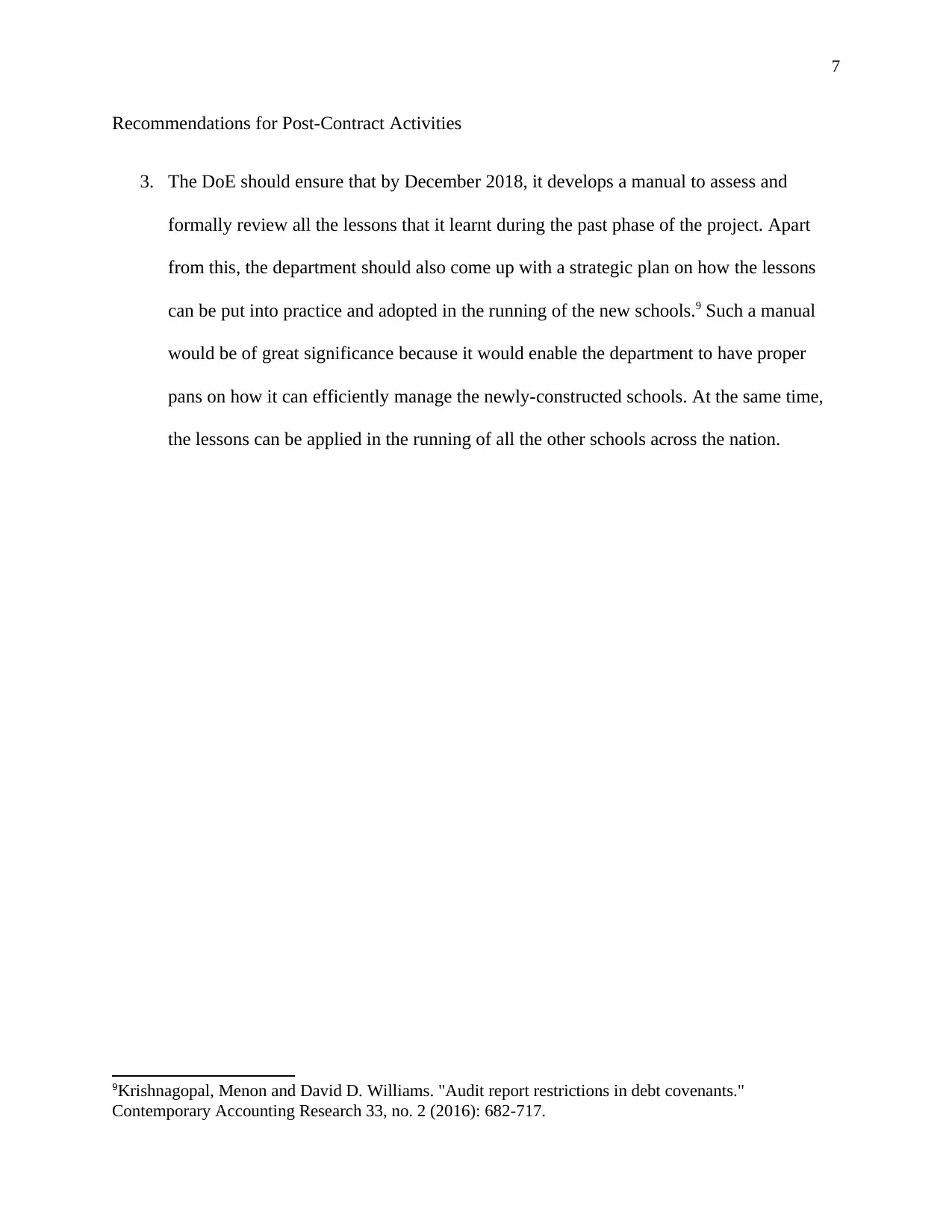
7
Recommendations for Post-Contract Activities
3. The DoE should ensure that by December 2018, it develops a manual to assess and
formally review all the lessons that it learnt during the past phase of the project. Apart
from this, the department should also come up with a strategic plan on how the lessons
can be put into practice and adopted in the running of the new schools.9 Such a manual
would be of great significance because it would enable the department to have proper
pans on how it can efficiently manage the newly-constructed schools. At the same time,
the lessons can be applied in the running of all the other schools across the nation.
9Krishnagopal, Menon and David D. Williams. "Audit report restrictions in debt covenants."
Contemporary Accounting Research 33, no. 2 (2016): 682-717.
Recommendations for Post-Contract Activities
3. The DoE should ensure that by December 2018, it develops a manual to assess and
formally review all the lessons that it learnt during the past phase of the project. Apart
from this, the department should also come up with a strategic plan on how the lessons
can be put into practice and adopted in the running of the new schools.9 Such a manual
would be of great significance because it would enable the department to have proper
pans on how it can efficiently manage the newly-constructed schools. At the same time,
the lessons can be applied in the running of all the other schools across the nation.
9Krishnagopal, Menon and David D. Williams. "Audit report restrictions in debt covenants."
Contemporary Accounting Research 33, no. 2 (2016): 682-717.
Paraphrase This Document
Need a fresh take? Get an instant paraphrase of this document with our AI Paraphraser
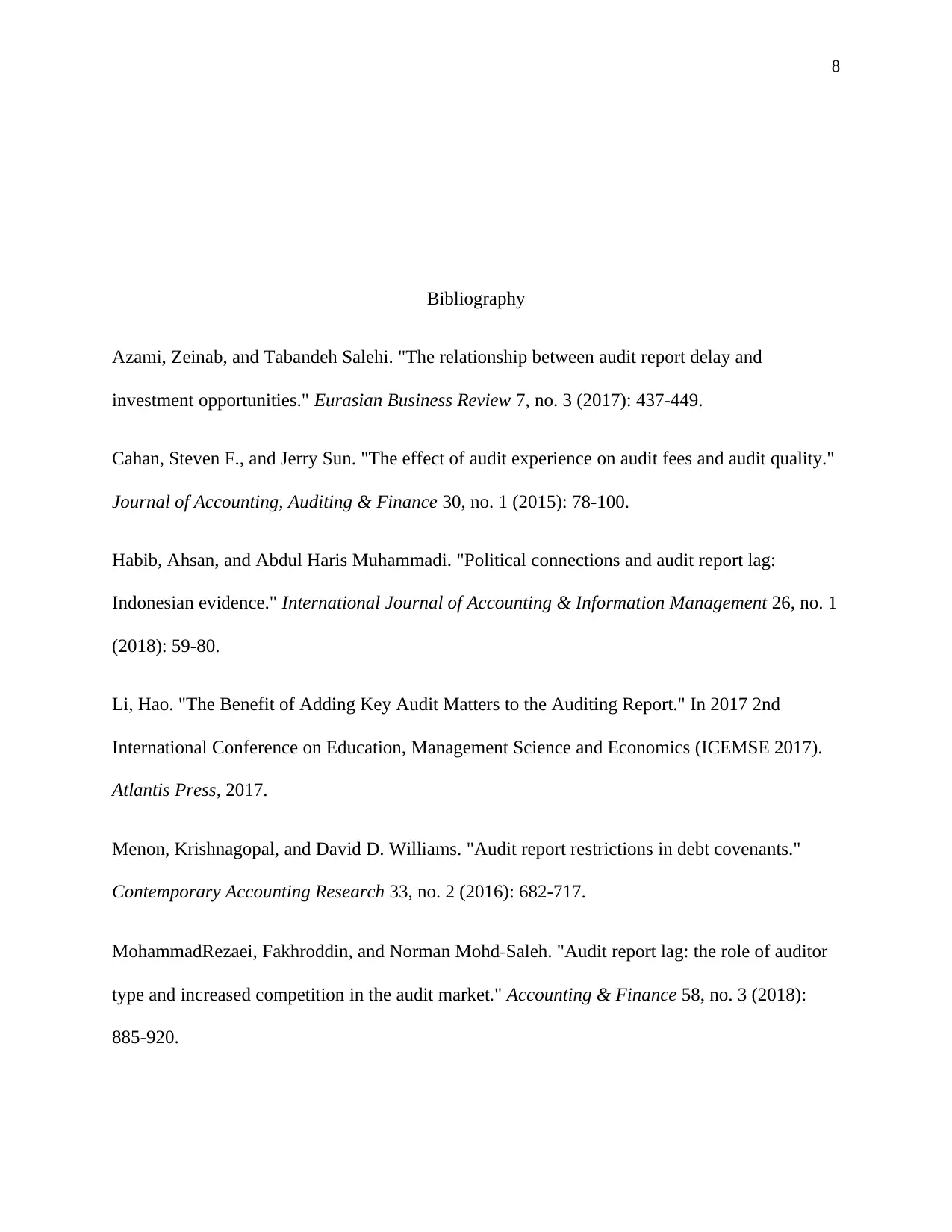
8
Bibliography
Azami, Zeinab, and Tabandeh Salehi. "The relationship between audit report delay and
investment opportunities." Eurasian Business Review 7, no. 3 (2017): 437-449.
Cahan, Steven F., and Jerry Sun. "The effect of audit experience on audit fees and audit quality."
Journal of Accounting, Auditing & Finance 30, no. 1 (2015): 78-100.
Habib, Ahsan, and Abdul Haris Muhammadi. "Political connections and audit report lag:
Indonesian evidence." International Journal of Accounting & Information Management 26, no. 1
(2018): 59-80.
Li, Hao. "The Benefit of Adding Key Audit Matters to the Auditing Report." In 2017 2nd
International Conference on Education, Management Science and Economics (ICEMSE 2017).
Atlantis Press, 2017.
Menon, Krishnagopal, and David D. Williams. "Audit report restrictions in debt covenants."
Contemporary Accounting Research 33, no. 2 (2016): 682-717.
MohammadRezaei, Fakhroddin, and Norman Mohd‐Saleh. "Audit report lag: the role of auditor
type and increased competition in the audit market." Accounting & Finance 58, no. 3 (2018):
885-920.
Bibliography
Azami, Zeinab, and Tabandeh Salehi. "The relationship between audit report delay and
investment opportunities." Eurasian Business Review 7, no. 3 (2017): 437-449.
Cahan, Steven F., and Jerry Sun. "The effect of audit experience on audit fees and audit quality."
Journal of Accounting, Auditing & Finance 30, no. 1 (2015): 78-100.
Habib, Ahsan, and Abdul Haris Muhammadi. "Political connections and audit report lag:
Indonesian evidence." International Journal of Accounting & Information Management 26, no. 1
(2018): 59-80.
Li, Hao. "The Benefit of Adding Key Audit Matters to the Auditing Report." In 2017 2nd
International Conference on Education, Management Science and Economics (ICEMSE 2017).
Atlantis Press, 2017.
Menon, Krishnagopal, and David D. Williams. "Audit report restrictions in debt covenants."
Contemporary Accounting Research 33, no. 2 (2016): 682-717.
MohammadRezaei, Fakhroddin, and Norman Mohd‐Saleh. "Audit report lag: the role of auditor
type and increased competition in the audit market." Accounting & Finance 58, no. 3 (2018):
885-920.
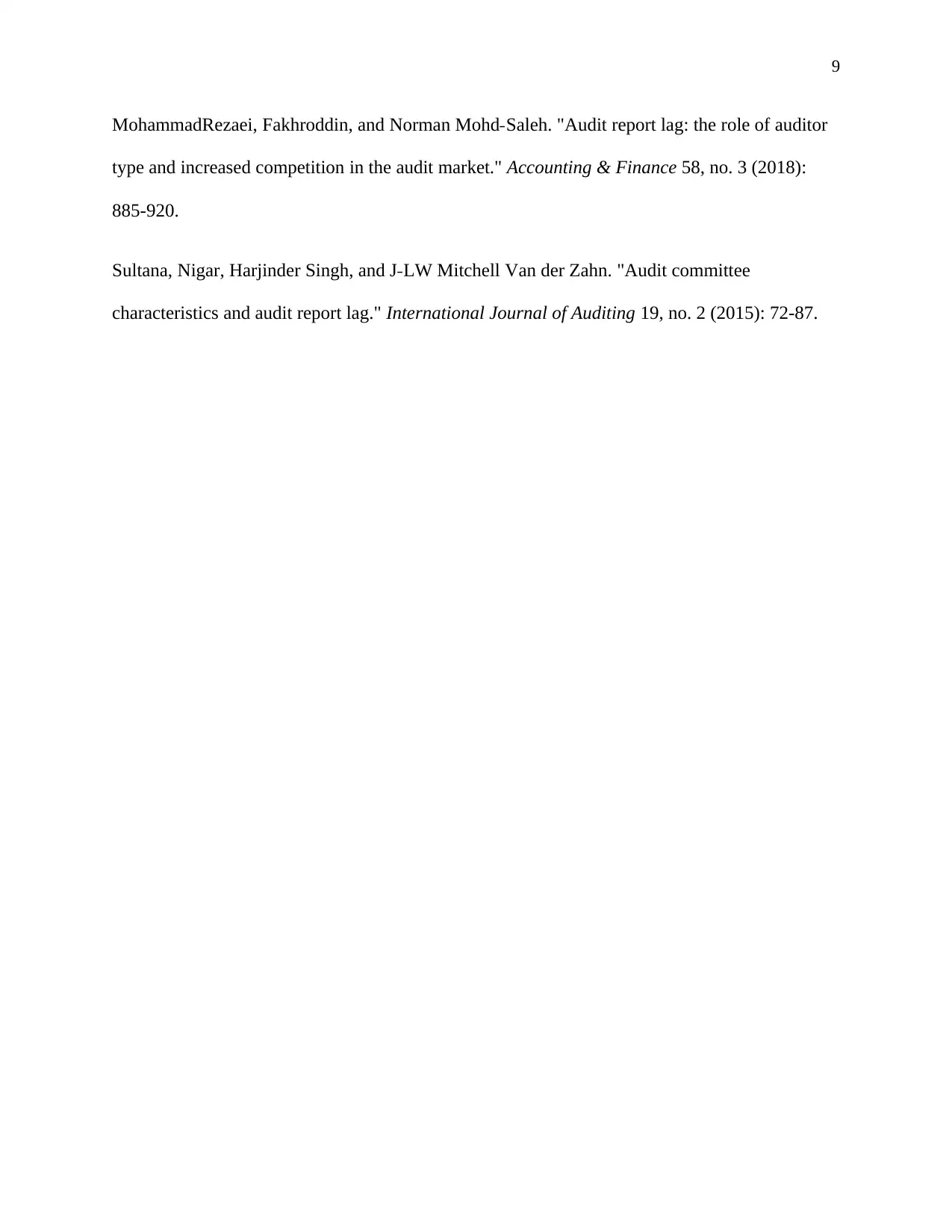
9
MohammadRezaei, Fakhroddin, and Norman Mohd‐Saleh. "Audit report lag: the role of auditor
type and increased competition in the audit market." Accounting & Finance 58, no. 3 (2018):
885-920.
Sultana, Nigar, Harjinder Singh, and J‐LW Mitchell Van der Zahn. "Audit committee
characteristics and audit report lag." International Journal of Auditing 19, no. 2 (2015): 72-87.
MohammadRezaei, Fakhroddin, and Norman Mohd‐Saleh. "Audit report lag: the role of auditor
type and increased competition in the audit market." Accounting & Finance 58, no. 3 (2018):
885-920.
Sultana, Nigar, Harjinder Singh, and J‐LW Mitchell Van der Zahn. "Audit committee
characteristics and audit report lag." International Journal of Auditing 19, no. 2 (2015): 72-87.
⊘ This is a preview!⊘
Do you want full access?
Subscribe today to unlock all pages.

Trusted by 1+ million students worldwide
1 out of 9
Related Documents
Your All-in-One AI-Powered Toolkit for Academic Success.
+13062052269
info@desklib.com
Available 24*7 on WhatsApp / Email
![[object Object]](/_next/static/media/star-bottom.7253800d.svg)
Unlock your academic potential
Copyright © 2020–2025 A2Z Services. All Rights Reserved. Developed and managed by ZUCOL.





